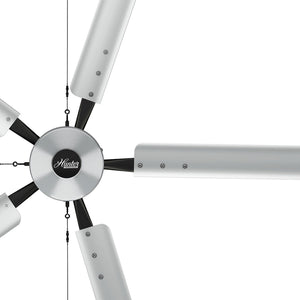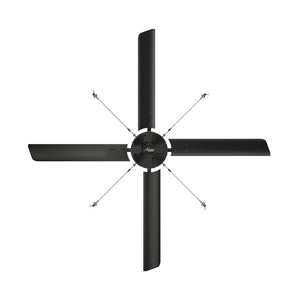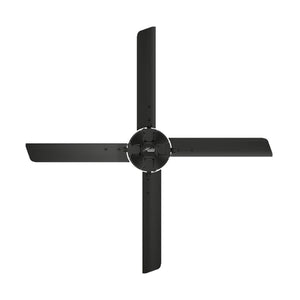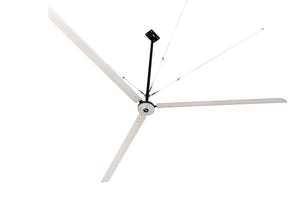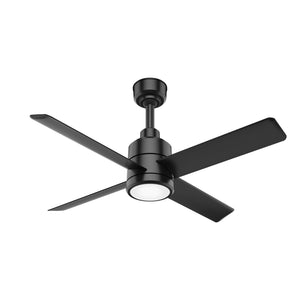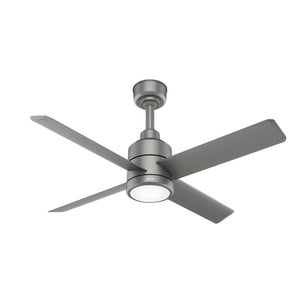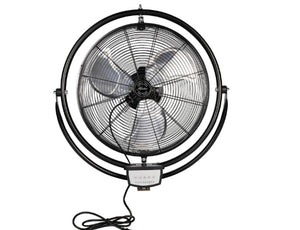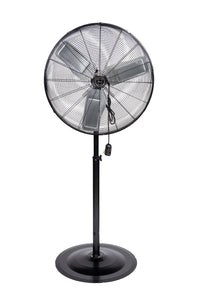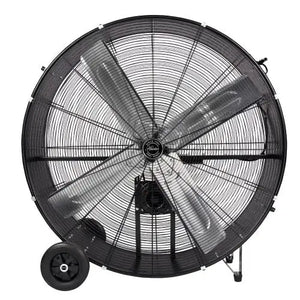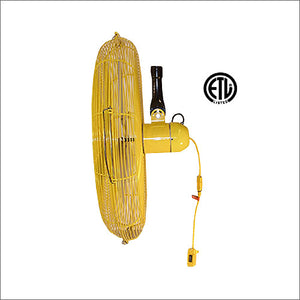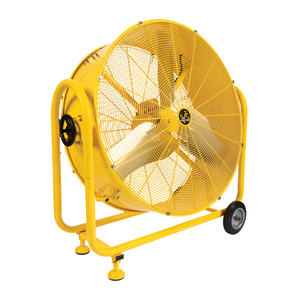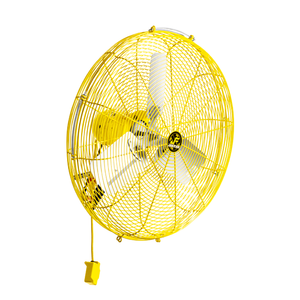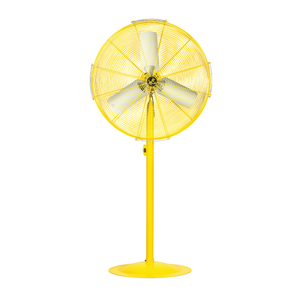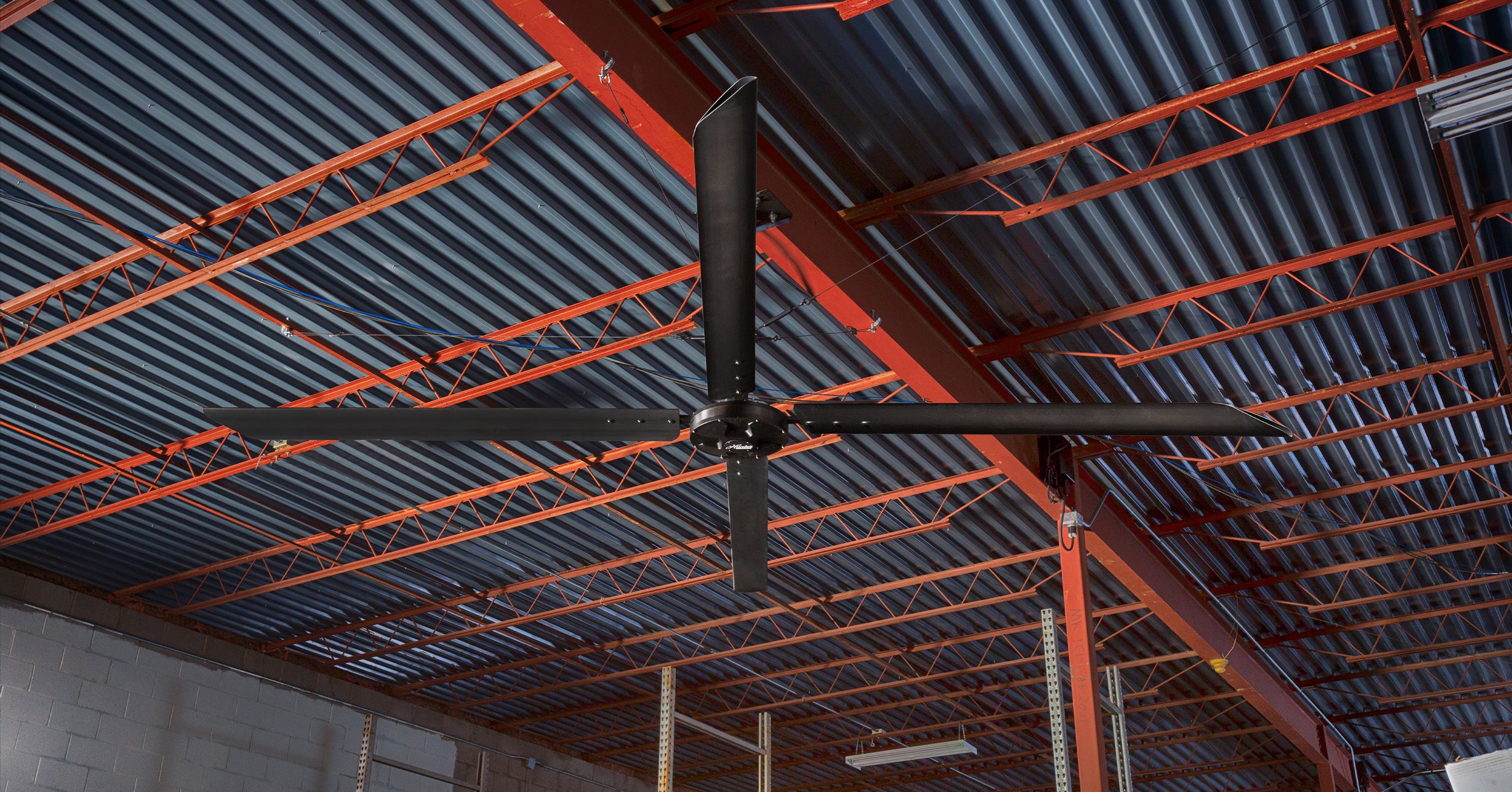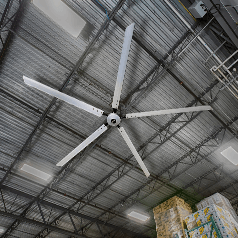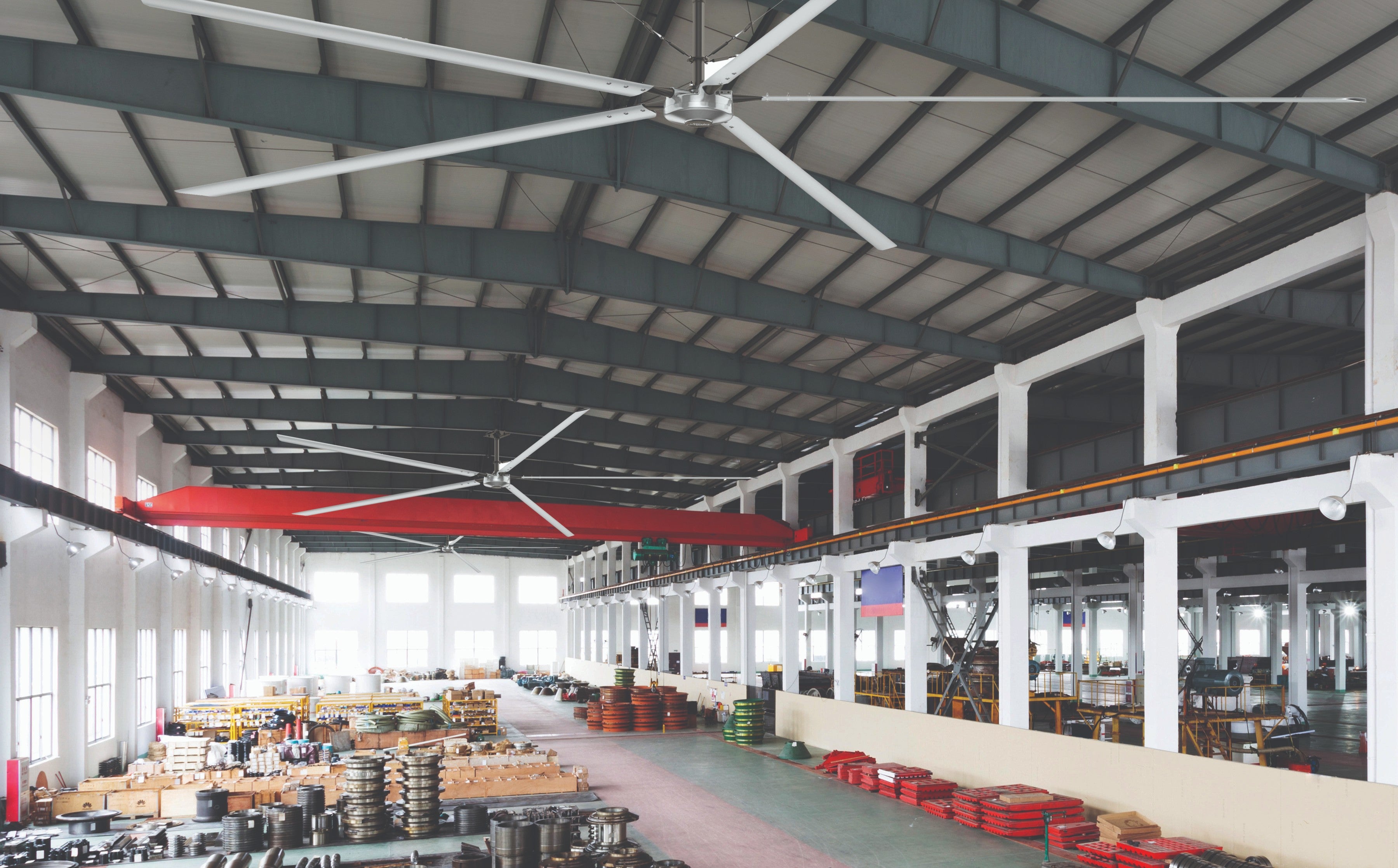The ECO line of ceiling fans represents a breakthrough from Hunter Industrial Fan. This fan, light in weight yet powerful in performance, is engineered and tested to deliver industrial-level air circulation consistently.
What a Heavy-Duty Industrial Ceiling Fan Can Do For You
A heavy-duty industrial ceiling fan is more than a set of oversized propellers casting a breeze; it's the unsung hero, ensuring machines run smoothly and the workforce remains comfortable. By mitigating overheating risks and providing uniform air distribution, these robust fans are indispensable.
Their longevity and efficiency are the difference between an average workspace and a productive powerhouse. Benefits of industrial ceiling fans for warehouses and other large spaces include:
- Optimal Air Circulation: Ensure even distribution of air throughout vast spaces.
- Temperature Regulation: Help maintain a consistent temperature, reducing the need for costly HVAC systems.
- Energy Efficiency: Consume less energy compared to multiple smaller fans or air conditioning units.
- Overheating Prevention: Protect machinery and equipment by dispersing hot air.
- Enhanced Worker Comfort: Create a pleasant working environment, boosting productivity.
- Reduced Humidity: Help prevent moisture buildup, which can lead to mold and equipment damage.
- Longevity: Built to last, requiring less frequent replacements.
- Noise Reduction: Operate quieter than multiple standard fans running simultaneously.
- Cost Savings: Reduce overall operational costs over time.
- Eco-friendly: Lower carbon footprint by utilizing energy more efficiently.
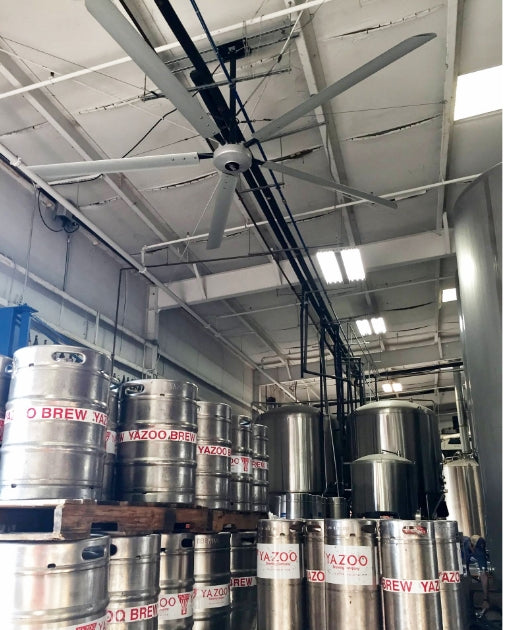
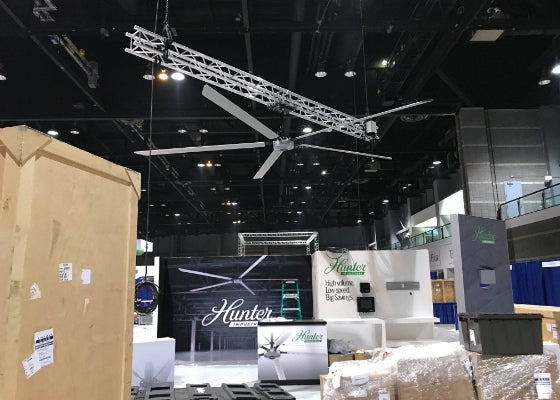
HVLS Fans vs. Traditional Ceiling Fans
When selecting the optimal ceiling fan for industrial settings, it's crucial to understand the differences and advantages of each type. One of the most notable categories is High-Volume, Low-Speed (HVLS) fans, which contrast sharply with traditional ceiling fans in design, function, and efficiency.
HVLS Fans
- Functionality: HVLS fans – like the Hunter Titan – are designed to move vast volumes of air at lower speeds. Their gentle but extensive airflow can cover a large area without causing disruptive drafts.
- Energy Efficiency: Like our other products in this category, the DDI HVLS fan consumes less energy than high-speed models, leading to significant savings on electricity bills.
- Temperature Regulation: Due to their design, HVLS industrial shop ceiling fans mix layers of air (stratification) effectively, creating consistent temperatures from ceiling to floor.
- Noise Levels: Often, these fans operate at lower noise levels due to their reduced speed, ensuring a quieter work environment.
Other Industrial Shop Ceiling Fans:
- Functionality: Traditional ceiling fans operate at higher speeds, which can lead to focused and intense airflow. They might not distribute air as uniformly as HVLS fans.
- Energy Consumption: High-speed fans tend to consume more energy, especially when multiple units are required to cool the same area that a single HVLS fan might cover.
- Temperature Regulation: While they can help in cooling areas quickly, the rapid movement might not address temperature stratification as effectively as HVLS fans.
- Noise Levels: Due to their high-speed operation, these fans can generate more noise, which might be disruptive in certain settings.
While both HVLS fans and traditional ceiling fans have their place in the market, the choice depends on the specific needs of the facility. HVLS fans excel in energy efficiency, noise reduction, and temperature destratification, making them ideal for vast open spaces like automotive service facilities. On the other hand, industrial air circulating fans like our Jan Fan are better suited for areas where rapid air movement is more critical than uniformity. As always, considering the specific needs of your facility will guide the best decision.
EXPLORE OTHER CATEGORIES
The Heavy-Duty Industrial Ceiling Fan With a Top-Tier Warranty
Every Hunter heavy-duty industrial ceiling fan is engineered for unparalleled performance and durability. Your assurance is our Limited Lifetime Warranty. We believe deeply in our product quality, which is why our Titan, ECO, and XP HVLS ceiling fans boast the industry's most robust warranty. We're not just selling fans; we're providing a promise of lasting excellence. Experience the unmatched reliability of our industrial shop ceiling fans firsthand. Terms and conditions apply.

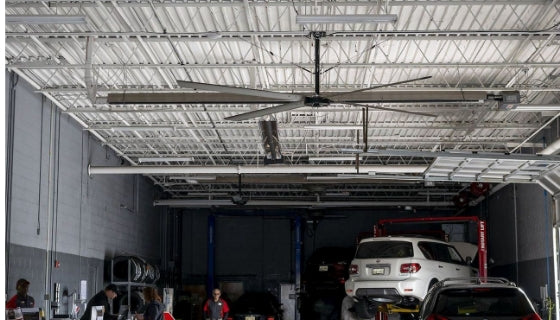
Everyone Is a Fan of Hunter's Customer Service Team
At Hunter, delivering the best industrial shop ceiling fans is just the beginning. We're with you every step of the way, offering unparalleled customer support. From the moment you place your order through delivery, installation, and regular cleaning, our dedicated team is there to assist you. Whether you have a query, need guidance, or face any concerns, we're just a call away. Connect with us today at 1-844-591-3267 and experience our commitment to the world-class service that sets us apart.
Choosing the Best Warehouse Ceiling Fan for Your Facility
Hunter provides various commercial warehouse ceiling fans engineered to meet the airflow needs of your facility. All are powered by direct-drive motor technology:
- Titan: The Titan is our flagship industrial warehouse ceiling fan, providing the optimal solution for cooling and air circulation in large commercial facilities. The fan has a diameter ranging from 14 to 24 feet.
- ECO: The ECO ceiling fan for warehouses is an economical solution that provides excellent air movement and temperature management for commercial facilities. The fan has a diameter of 8 to 24 feet.
- XP: The XP offers comfort year-round. It's an ideal solution for smaller warehouses, with a diameter of 7 to 14 feet.
- DDI: The DDI ceiling fan is a simple but powerful ceiling fan providing reliable airflow to distribution centers, warehouses, and other large workspaces. Choose from two aerodynamically efficient blade sizes – 20 feet or 24 feet.
Frequently Asked Questions About Large Industrial Ceiling Fans
Below are answers to some of the questions we've received about large industrial ceiling fans. Please get in touch with us for more information.
How Energy Efficient Are Large Industrial Ceiling Fans Compared to HVAC Systems?
How Long Is the Typical Lifespan of a Heavy-Duty Industrial Ceiling Fan?
Are There Noise Concerns With Industrial Ceiling Fans for Warehouses?
Start Your Hunter Industrial Fan Journey
At Hunter Industrial We Know Air. Our Industrial And Commercial Fans Are Carefully Crafted To Meet The Needs Of Your Detailed And Delicate Industry. Our Experts Are Ready To Work With You To Design A Perfect Airflow Plan To Enhance Your Space. Fill Out The Form To Connect With Us Today.
Like Talking To Real People?
So do we. Reach a Hunter Industrial sales rep
1-844-591-3267 (FANS)
Contact Info
Take Comfort in Hunter Large Industrial Ceiling Fans
Increase the efficiency and comfort of your expansive spaces with Hunter large industrial ceiling fans. Crafted with precision and designed for unparalleled performance, our fans optimize airflow and redefine the standards of durability and energy conservation. In essence, a heavy-duty industrial ceiling fan plays a silent yet pivotal role in maintaining the balance and productivity of industrial environments like yours. Transform your space today!

 100% Secure Payments
100% Secure Payments